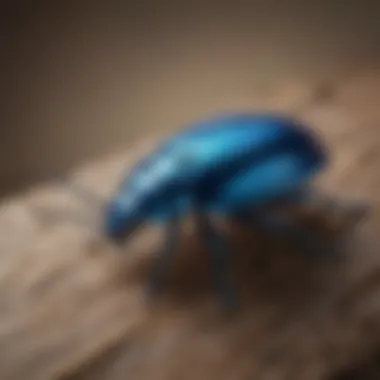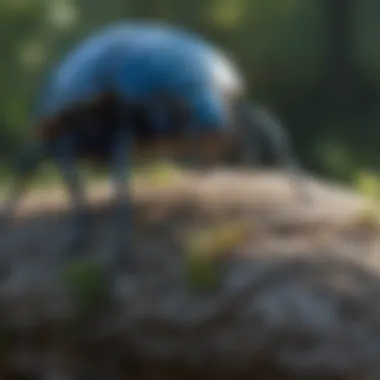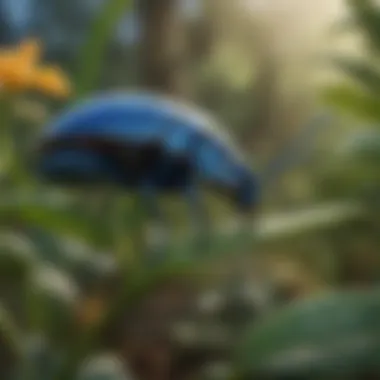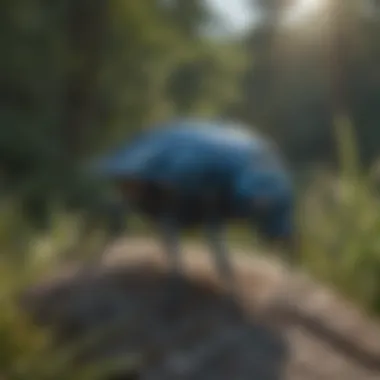Exploring Rhode Island's Unique Blue Bug


Intro
The blue bug of Rhode Island captures the interest of many who reside in or are connected to the region. This insect, often overlooked, brings forth unique challenges and advantages within the local ecosystem. Understanding its characteristics and behavior is vital for harmonizing human lives with the natural world around them. This article will explore the essentials of the blue bug, its habitat, interactions with other species, and practical advice for residents.
Understanding Pests
Definition of Pests
Pests are organisms that cause harm or annoyance to humans, plants, or animals. They can be insects, rodents, or even certain plants. The blue bug, while part of Rhode Island’s biodiversity, can be classified as a pest due to its potential to disrupt everyday life. Understanding what makes an insect a pest helps in identifying what actions may need to be taken.
Importance of Pest Identification
Accurate identification of pests is crucial for effective management. In the case of the blue bug, recognizing its unique traits assists in determining whether it poses a threat or can coexist peacefully with humans. Failure to identify a pest appropriately can lead to unnecessary measures that may harm the ecosystem further.
"Effective pest management begins with knowledge and understanding, essential for fostering coexistence."
Ecosystem Role of the Blue Bug
The blue bug plays a significant role in the local ecosystem of Rhode Island. It acts as both a pollinator for native plants and a food source for various predatory species. These interactions highlight the insect's contribution to maintaining ecological balance.
Prevention Techniques
Home and Garden Preventative Measures
To manage the blue bug effectively, homeowners can implement various preventative measures. Some methods include:
- Sealing Cracks: Ensure that all potential entry points into the home are sealed to prevent the insects from entering.
- Regular Maintenance: Keep gardens tidy, as debris can provide nesting areas for pests.
- Creating Barriers: Use nets or other barriers to protect plants from infestation.
Seasonal Prevention Tips
In Rhode Island, the behavior of the blue bug may change with the seasons. Residents can consider the following tips:
- Spring Preparation: Before plants blossom, inspect and secure areas to thwart any potential infestations.
- Summer Monitoring: Regularly check gardens and homes for signs of blue bugs and take notes of their activity patterns.
- Winter Clean-Up: As fall approaches, clear out unwanted organic matter that can harbor pests through winter months.
Eco-Friendly Pest Control Solutions
Overview of Sustainable Practices
Sustainable pest control emphasizes solutions that are less harmful to the environment. By focusing on natural interactions within ecosystems, it is possible to manage pest populations without using harsh chemicals.
Natural Remedies and Their Effectiveness
Several natural remedies have shown effectiveness against common pests, including:
- Neem Oil: Derived from the neem tree, it can disrupt the life cycle of pests.
- Diatomaceous Earth: This powder can be spread in gardens to deter insects without causing harm to beneficial species.
Educating oneself about these solutions can lead to more harmonious living conditions with the blue bug and other local insects.
Prologue to the Blue Bug
The blue bug of Rhode Island holds significant relevance within the local ecological framework. Understanding this insect is crucial for both environmental awareness and pest management. By delving into its characteristics, behaviors, and interactions, we gain insight into the delicate balance of local ecosystems. Additionally, recognizing the blue bug's role can empower residents to coexist harmoniously with this unique species.
Defining the Blue Bug
The blue bug, scientifically known as Chrysomela sp., is a small beetle with distinct blue features. Its vivid coloration serves as a form of warning to potential predators. The blue bug is not just another insect; it plays a pivotal role in its habitat. Its diet primarily consists of various plants, making it an herbivore. This feeding habit connects it directly to the local flora and, consequently, to the overall health of the ecosystem. Understanding its identity, both scientifically and in a common context, is essential for further discussions about its ecological importance.
Historical Context in Rhode Island
Historically, the blue bug has been a part of Rhode Island's landscape for many years. The state's varied geography provides an excellent environment for these insects to thrive. Their presence can be traced back to various local studies that document biodiversity. The blue bug's interactions with both plants and other species have been noted as vital to local agriculture and natural landscapes. As human developments have increased over the years, the blue bug's habitat has faced changes. These shifts have led to a greater need for understanding their role and ensuring their protection within the ecosystem.


"The blue bug represents a unique intersection of culture and environment, emphasizing the need for conscientious pest management."
By exploring these facets, we can appreciate the blue bug's historical significance and advocate for its conservation.
Taxonomy and Identification
Taxonomy and identification are essential for understanding the blue bug's place within Rhode Island's ecosystem. By categorizing and identifying this insect, we gain insight into its biological relationships and environmental interactions. This knowledge is crucial for both ecological research and pest management strategies. Recognizing the blue bug's specific traits helps homeowners make informed decisions about coexistence.
Physical Characteristics
The blue bug is notable for its striking coloration and distinctive shape. Generally, it exhibits a vibrant blue hue that varies in intensity. The exoskeleton is smooth, which helps in reflecting light. This attribute plays a role in its camouflage among vegetation. Its legs are slender, allowing for agile movement and quick escapes from predators.
Measurements typically range from one to three centimeters in length. Observers may note the large compound eyes, which improve its vision in low light. The antennae are long and segmented, aiding in sensory perception. Overall, these physical traits are not merely aesthetic; they contribute to the bug's survival within its habitat.
Life Cycle Stages
Understanding the life cycle of the blue bug involves examining distinct stages: egg, nymph, and adult. Each stage has unique characteristics and requirements.
- Egg Stage: The female lays eggs in clusters, often hidden in leaf litter. This provides protection from predators and harsh weather.
- Nymph Stage: Nymphs hatch from eggs and resemble smaller versions of adults but lack wings. They go through several molts, growing larger with each phase.
- Adult Stage: After several weeks, nymphs mature into adults. This phase marks reproductive capability. Adults continue to feed and reproduce, maintaining the population.
Understanding these stages is crucial for effective pest management. Identifying whether a bug is an adult or nymph can influence control measures.
Each stage of the blue bug’s development signifies opportunities and challenges in its environment. Homeowners can use this knowledge for better interactions with these insects, ensuring positive ecological impact.
Distribution and Habitat
Understanding the distribution and habitat of the blue bug in Rhode Island is essential. It allows us to appreciate how this insect interacts with its environment and the role it plays in the local ecosystem. The geographical spread and preferred habitats of the blue bug directly influence its survival, reproductive success, and interactions with other species.
Geographic Range in Rhode Island
The blue bug is predominantly found across various regions in Rhode Island. Its range extends from coastal areas to more wooded inland sites. This insect is particularly associated with moist, shaded environments that provide shelter and food resources. Areas such as wetlands, marshes, and even gardens often serve as hotspots for the blue bug population.
The Newport and Bristol counties are noted for having significant populations due to their diverse plant life. These areas are rich in the nutrients required for the blue bug's survival. The distribution is influenced by climate, availability of food, and presence of predators. Knowing where the blue bug is found helps in understanding its ecological role.
Common Habitats
Common habitats of the blue bug include:
- Wetlands: These regions provide ample moisture and nutrients. They support plant life that is essential for feeding the blue bug.
- Gardens: Well-maintained gardens with various flowering plants attract the blue bug. They depend on the nectar and leaves from these plants.
- Forested Areas: Shaded environments that offer shelter from direct sunlight and protection from predators.
- Grasslands: These areas provide ample vegetation, allowing for easy mobility and foraging opportunities.
The presence of the blue bug indicates a healthy local ecosystem.
Behavior and Ecology
Understanding the behavior and ecology of the blue bug is crucial for grasping its role in Rhode Island's ecosystem. The interactions of this insect with its environment significantly influence local biological dynamics. Knowing where it feeds, how it reproduces, and how it interacts with other species helps us understand its ecological significance. This understanding aids in effective pest management strategies and conservation efforts.
Feeding Habits
The feeding habits of the blue bug reveal much about its ecological niche. These insects primarily feed on organic matter, including decaying plant material. They possess specialized mouthparts that allow them to break down tough plant fibers and extract essential nutrients. The decomposition process facilitated by blue bugs plays an important role in nutrient cycling. This process returns vital nutrients back to the soil, enriching it for future plant growth.
Key Points on Feeding Habits:
- Blue bugs are mainly detritivores.
- They contribute to soil health through decomposition.
- Feeding habits influence local plant communities.
Additionally, the blue bug's feeding behavior impacts other species in its habitat. For example, by feeding on decomposing matter, it helps control fungal populations. This balance ensures a healthy environment for other organisms, like plants and beneficial insects. Understanding these interactions can help gardeners maintain thriving landscapes while considering blue bugs' needs.
"The blue bug’s feeding habits are a vital part of the ecosystem, contributing to the health of the soil and the overall biodiversity."
Reproductive Strategies
Reproduction is another fundamental aspect of the blue bug's behavior. These insects exhibit a variety of reproductive strategies that ensure their survival. Mating usually occurs in spring, when environmental conditions become favorable. Females lay eggs in protected areas, such as under leaf litter or inside decomposition sites, which offers safety from predation.


The process of reproduction involves courtship behaviors, where males display certain traits to attract females. This can include the production of pheromones or physical displays. The female then selects mates based on these traits, which can indicate genetic fitness.
Key Points on Reproductive Strategies:
- Mating takes place primarily in spring.
- Females choose mates based on characteristics.
- Egg-laying happens in safe environments.
These reproductive habits not only ensure the continuation of the blue bug population but also affect the structure of local ecosystems. The presence of numerous blue bugs can provide a food source for predators, thus maintaining the food web balance. By understanding both feeding and reproductive behaviors, we can better appreciate the complex interactions that sustain Rhode Island's ecological health.
Interactions with Other Species
Interactions between the blue bug of Rhode Island and other species illustrate the complexity of local ecosystems. Such interactions are not just fascinating; they serve critical roles in maintaining ecological balance. Understanding these relationships offers insights into how the blue bug contributes to, and is affected by, its environment.
Predators and Prey Relationships
The blue bug engages in a myriad of interactions with both predators and prey. These relationships depict a finely tuned balance that influences not only the blue bug but also the broader ecosystem. Common predators of the blue bug include spiders, birds, and various insectivorous mammals. Their predation can significantly impact blue bug populations, regulating their numbers and minimizing potential overpopulation, which can disrupt local biodiversity.
On the other hand, the blue bug itself acts as prey for numerous species. This dynamic serves as a food source, ensuring that these predators thrive. A healthy population of blue bugs can support these predators, highlighting their role in the food web. Such reciprocal interactions illustrate how each species depends on the other for survival, thus shaping the ecological landscape of Rhode Island.
Symbiotic Relationships
The blue bug also engages in symbiotic interactions, which can be mutualistic or parasitic. Mutualism occurs when both species benefit from the interaction. For instance, some plants may produce nectar that attracts blue bugs, providing them with sustenance while simultaneously enhancing the plant's pollination process. In this way, the blue bug indirectly supports plant reproduction, contributing to the overall health of the ecosystem.
Conversely, parasitism can occur with certain organisms exploiting the blue bug for their own benefit, often at the bug's expense. These relationships, while often harmful, are essential for understanding the various pressures blue bugs face in their habitat.
In summary, examining interactions with other species provides a lens through which one can observe the blue bug's integral role within Rhode Island's ecological framework. These connections not only enhance our knowledge of blue bugs but also emphasize the importance of maintaining balanced ecosystems.
Impact on Local Ecosystems
Understanding the blue bug's impact on local ecosystems is crucial for grasping its significance within Rhode Island's biodiversity. This insect plays a multifaceted role that not only supports various food webs but also influences the health of the environment.
Role in Biodiversity
The blue bug contributes significantly to biodiversity in Rhode Island. Its presence supports a delicate balance within the ecosystem. As a herbivore, the blue bug feeds on specific plants, which helps to control plant populations. This natural regulation can prevent any one species from dominating the habitat, thus promoting a wide variety of plants and other organisms.
Additionally, the blue bug serves as a food source for various predators, such as birds and small mammals. These relationships illustrate the interconnectedness of species within the ecosystem. If the blue bug population fluctuates, it can affect the entire food chain. Therefore, it is vital to monitor its status, as a decline could signify larger ecological changes or stressors in the environment.
Influence on Plant Life
The blue bug's impact on plant life is noticeable as well. By feeding on certain vegetation, it helps to shape the composition of plant communities. Some plants may benefit from the selective feeding behaviors, which can encourage growth by removing competing species. In this way, the blue bug can facilitate the adaptation of certain plants to their environment.
Furthermore, the waste produced by blue bugs can enhance soil quality. As they contribute organic matter through their droppings, they nourish the soil. This process leads to improved fertility, supporting a greater diversity of plant life.
"Each species, including the blue bug, holds a unique role that affects the entire web of life within its ecosystem."
Unquestionably, understanding how the blue bug influences ecological dynamics will aid in preserving the delicacy of Rhode Island's natural environments. Recognizing its role offers insight into the health of our ecosystems, guiding conservation efforts and pest management strategies.
Pest Management Considerations
Pest management is an essential aspect of maintaining a balanced ecosystem, especially in regions like Rhode Island where the blue bug plays a significant role. Understanding the dynamics of how this insect interacts with its environment can help homeowners address any issues that may arise. Furthermore, knowing the characteristics of the blue bug can lead to more informed decisions when it comes to pest management strategies.
Effective pest management should prioritize methods that respect both the local ecosystems and the existence of beneficial species. It is crucial for residents to recognize the symptoms or signs that indicate the presence of blue bugs in their vicinity. Awareness helps in early detection of any problems, which can mitigate potential damage to plants and crops in the surrounding area.
Identification of Problems
Identifying problems associated with blue bugs requires careful observation. Common indicators include:
- Unusual damage to garden plants or crops: Blue bugs may feed on foliage, leading to noticeable changes in the health of plants.
- Presence of residue: Look for honeydew or sticky substances on leaves, often left behind by insects.
- High insect activity: Observing an increased presence around your property may indicate a population growth.
For homeowners, these signs can be alarming. Recognizing these issues early on allows for quicker action, potentially reducing the spread of any infestation. Conducting regular inspections of gardens and outdoor spaces can aid in identifying problems before they escalate into larger ones, thus preserving the integrity of local flora.
Sustainable Solutions


Addressing the problem of blue bugs in a sustainable manner is paramount for the health of ecosystems. Here are several strategies homeowners can consider:
- Natural Predators: Encourage birds, spiders, and other insects that feed on blue bugs to inhabit the area. They play a vital role in controlling blue bug populations.
- Companion Planting: Planting certain herbs or flowers can deter blue bugs naturally. For example, marigolds are known for their pest-repellent qualities.
- Manual Removal: In smaller infestations, manually removing blue bugs can be effective. This method avoids harmful chemicals and contributes to learning about the species.
By embracing these sustainable practices, homeowners contribute to the balance of their local ecosystem while effectively managing blue bugs. As responsible stewards of the environment, it is important to implement strategies that are not only effective but also supportive of environmental health.
Conservation and Protection
Conservation and protection of the blue bug in Rhode Island is crucial for maintaining the ecological integrity of the region. As a native insect, the blue bug plays a significant role in local ecosystems. Its presence is a marker of a healthy environment. Protecting this species means ensuring the balance of biodiversity, which is important for the sustainability of various plants and animals in the area.
Ecological systems are interconnected. When one species faces threats, it can lead to a cascade of effects on other organisms. Thus, conservation efforts for the blue bug not only help this insect but also the broader ecosystem. Strategies focused on habitat protection and restoration can result in healthier environments for both the blue bug and the wildlife that depend on it.
Additionally, understanding the benefits of conservation can lead to better engagement from the community.
"Protecting the blue bug is essential for the overall health of Rhode Island's ecosystems."
Threats to the Blue Bug Population
The blue bug faces several threats that jeopardize its survival. These include habitat destruction, pesticide use, and climate change. Urban development is a primary factor, as it reduces natural habitats. The loss of these areas directly impacts the ability of the blue bug to thrive. Moreover, the use of chemical pesticides may eliminate not only pests but also beneficial insects like the blue bug. This diminishes their populations and disrupts the ecological balance.
Climate change is another significant threat. Fluctuations in temperature and weather patterns can affect reproductive cycles and food availability. As local ecosystems shift, the adaptability of the blue bug is crucial for its survival. Without adequate measures to address these threats, the blue bug's future in Rhode Island remains uncertain.
Conservation Efforts in Rhode Island
Several conservation efforts are currently in place aimed at protecting the blue bug and its habitat in Rhode Island. Local organizations and state agencies are working together to raise awareness about the importance of the blue bug. They initiate educational campaigns to inform the public about the significance of preserving this species.
Habitat restoration efforts are also underway. Restoring native plants in areas where the blue bug thrives can improve overall biodiversity. This not only benefits the blue bug but also supports other insects and wildlife native to Rhode Island. Community involvement is encouraged, as local residents can play a vital role in monitoring blue bug populations and reporting their findings.
Additionally, regulations on the use of certain pesticides are being examined. Limiting harmful chemicals ensures a safer environment for the blue bug and other species, thereby contributing positively to ecosystem health.
In summary, conservation efforts are critical for the future of the blue bug and the ecosystems of Rhode Island. These initiatives highlight the interconnectedness of species and underscore the need for collective responsibility in environmental stewardship.
Future Research Directions
As researchers continue to explore the ecological significance of the blue bug in Rhode Island, identifying future research directions becomes essential. Understanding the blue bug's behaviors, interactions, and roles in local environments can lead to more effective conservation strategies and pest management practices. This section addresses critical gaps in current knowledge and emphasizes the necessity of ongoing study in this area.
Gaps in Current Knowledge
While there is existing literature on the blue bug, several gaps remain. Notably, there is not enough comprehensive data on the blue bug's precise ecological roles. Researchers lack information on its interactions with other species in detail. This includes understanding how it influences plant health and what specific environmental conditions support its lifecycle and population dynamics. Moreover, studies that include long-term observations are limited. More extensive research could help establish causative relationships between environmental changes and blue bug populations. Understanding these factors can lead to improved habitat conservation techniques.
Importance of Ongoing Study
Ongoing research is crucial not only for understanding the current status of blue bug populations but also for predicting future trends. As climate change alters habitats, observing these changes will be essential. This ongoing study can potentially uncover new relationships between the blue bug and its environment, which might not be evident during static observations. Longitudinal studies focusing on breeding patterns, seasonal behaviors, and reactions to pest management strategies could provide valuable insights.
Additionally, engaging the local community in research efforts can promote awareness. This collaboration can also yield indigenous knowledge, assisting scientists in their research. For residents, understanding more about the blue bug can foster a sense of stewardship towards local biodiversity.
Finale
The conclusion serves as a critical component of this article, encapsulating the essence of the various discussions held regarding the blue bug of Rhode Island. In summarizing the knowledge presented throughout the piece, it reinforces the significance of understanding this unique insect and its place within the local ecosystem.
The blue bug is not merely an insect; it holds an important role in maintaining the ecological balance. By summarizing its characteristics, behavior, and interactions with other species, readers can appreciate how it influences both the environment and human activities.
Summary of Key Points
Throughout the article, we have explored several key aspects related to the blue bug, including:
- Defining the Blue Bug: An insight into its taxonomy and unique features.
- Habitat and Distribution: Understanding where it thrives within Rhode Island.
- Behavior and Ecology: Its feeding habits and reproductive strategies.
- Interactions with Other Species: The complex relationships it has within the ecosystem.
- Impact on Local Ecosystems: Its role in biodiversity and influence on plant life.
- Conservation Efforts: Identifying threats and the ongoing measures undertaken to protect it.
Each section contributes to a fuller understanding of how the blue bug interacts with its environment and the implications for local ecosystems and pest management initiatives.
Final Thoughts on the Blue Bug's Role
Reflecting on the blue bug's role in Rhode Island, it becomes clear that preserving this species is integral not only for ecological stability but also for educating the public about biodiversity.
Households that understand the importance of the blue bug may foster coexistence, reducing reliance on pesticides, which can have unintended consequences on the environment. Awareness cultivated through this article may lead to proactive measures in conservation efforts, allowing future generations to appreciate the blue bug as a valuable asset in the state's ecological fabric.
"Understanding the interconnectedness of species is critical for sustainable living. The blue bug exemplifies how one organism can influence a larger ecosystem."



